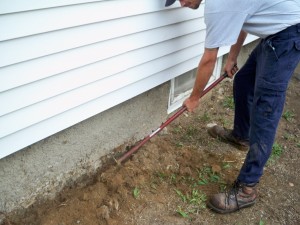Today we did a termite treatment in Beacon Falls, CT. The customer was an engineer and wanted to know some of the more technical things about termite control. By his own admission he just didn’t want to know that the bugs we gone. He wanted to know how and why they were gone. Fair enough, I would tell him and then I figured I’d tell everyone else. By the way this story has a funny, but true ending; keep reading.
First, understand that no two homes are alike and this home was a relatively easy home to provide a termite treatment to. So, if your in the pest control industry already and reading this move on, there won’t be any breaking news here about how to treat a home for termites.
The conversation with the homeowner started with the type of material we were going to use. We picked an insecticide called Termidor. This product or “termiticide” as we call it in the pest control industry is a non-repellent termiticide. Essentially, non-repellent termiticides allow insects to pass through the product while it’s in the soil and pick up a lethal dose that doesn’t kill them immediately. Instead, it allows the termite to spread the product among its nest mates like a virus. For every termite that passes through the product we’re sure to kill many more. This is a good thing as termite colonies can be large.
Next, the customer wanted to know where do termites come from? I’m going to keep this one short because it could be a very long answer, but essentially they come from the soil. In CT we only have the eastern subterranean termite. Within a termite colony there’s a king, queen, soldiers, workers and reproductive’ s. Each caste has a separate function and they feed on all cellulose based products. The member of a termite colony that does all the damage is the worker termite. It’s about the size of a grain of rice, it’s white and feeds 24/7
As the conversation continued he wanted to know. If termites come from the soil, how are you going to get through the tar and concrete around my home, do you just spray? I explained that first we inspect for utilities such as gas, oil and buried electric lines. If we’re confident that none exist we use a 1/2″ hammer drill to drill through the area right up against the foundation at 12″ intervals. We then pump Termidor into the holes at a rate of 4 gallons per 10 linear ft. After we’re finished we then plug the holes with a cork and close them permanently with tar patch or cement.
 The homeowner then asked; so where there’s no tar or cement do you make holes in those areas as well?. I explained that his idea was correct, but the process was wrong.
The homeowner then asked; so where there’s no tar or cement do you make holes in those areas as well?. I explained that his idea was correct, but the process was wrong.
First, we dig a 3″x6″ trench; we then use treating rods to rod into the soil and apply Termidor at a rate of 4 gallons per 10 linear feet per foot of depth to a minimum depth of 4 ft ( say that three times fast). We have to avoid wells and watch for leakage into the basement. If leakage does occur it is easily dealt with in the field. If your home has a well, that also is not a problem as long as we know where it is and how far away from the home it is. If your well is close to the home, we can provide you with different options for treatment.

At this point the homeowner was confident that choosing Envirocare Pest Control to provide a termite treatment to his home was a good idea. I asked if he had any other questions, he replied no. However, I do have a statement. I thought here we go I’m in trouble.
Instead he say’s “I’m already familiar with termite treatments this is my second house with termites, I got your name from a friend and you’re as competent as my friend suggested”. We had laughed and did the job.
I think that to often in the pest control industry and all trades for that matter we forget that some customers really do want to know the specifics.
If you want to know the specifics of how Envirocare Pest Control can solve your pest problem, call 1-888-879-6481. My name is Dave, I own the company and I’d be happy to share.
